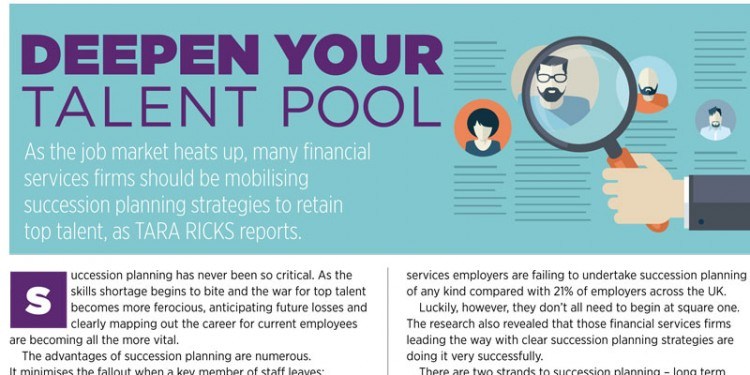As the job market heats up, many financial services firms should be mobilising succession planning strategies to retain top talent, as Tara Ricks reports.
View the published article by downloading the PDF document.
Succession planning has never been so critical. As the skills shortage begins to bite and the war for top talent becomes more ferocious, anticipating future losses and clearly mapping out the career for current employees are becoming all the more vital.
The advantages of succession planning are numerous. It minimises the fallout when a key member of staff leaves; knowledge is carried through into the next generation; a successor can be put in place much more quickly; and employers save on the training (and time) needed to bring external talent up to speed.
Giving employees a defined sense of purpose within an organisation also works as a powerful retention tool, helping to staunch the flow of ambitious high-flying talent out of an organisation.
In a perfect world, every new hire should be sized up not only against their qualification for the immediate role, but also against their potential to fill future positions, when workers higher up the career ladder inevitably go elsewhere. It’s wise for employers to keep in mind the future potential of a candidate during their assessment. Assessing where they could fit into the company in one year, two years, three years and five years provides good guidelines, given the average tenure of most financial services professionals. Identifying potential future leaders to fill key positions needs to be wrapped up in the strategy of every ambitious organisation. It may therefore come as a surprise that the financial services sector is slipping behind the rest of the UK in terms of putting theory into practice.
TWO STRANDS TO PLANNING
Randstad Financial & Professional recently polled a sample of leading HR directors. The results revealed that 25% of financial services employers are failing to undertake succession planning of any kind compared with 21% of employers across the UK.
Luckily, however, they don’t all need to begin at square one. The research also revealed that those financial services firms leading the way with clear succession planning strategies are doing it very successfully.
There are two strands to succession planning – long term and short term. A short-term strategy simply identifies an immediate competent replacement should a vital team member leave, while a long-term strategy focuses on identifying future potential leaders and developing the skills they will need to take over at some point in the future. About two-thirds (63%) of financial services firms using succession planning undertake both short- and long-term strategies, compared with less than half (44%) of the UK’s blue-chip employers. And while more than a fifth (22%) of UK-wide firms are concentrating solely on short-term succession planning – in financial services, it’s just an eighth (13%).
SUPPORT FOR JUNIOR STAFF
This means that financial services firms place greater importance on developing talent for the future, rather than simply having a successor lined up if a key member of the team gets hit by a bus. Often, this includes supporting more junior staff.
Supporting this notion, the research also found that 43% of financial services employers focus on more than just the top layer of management compared with the UK average of 37%.
INCENTIVES TO STAY
This is becoming all the more vital, as middle management tiers become harder to source. In the past, succession planning has been focused on a handful of top level positions such as CFOs and FDs. Broadening the net helps ease the pressure of filling middle manager positions, roles which are likely to come up frequently. And it gives those potentially crucial employees more of an incentive to stay.
The quarter of financial services firms off the mark would be wise to implement succession planning strategies quickly. As the jobs market heats up, it’s only going to become more challenging to retain top talent. Providing a clear sense of purpose is an easy way to solve the talent puzzle.

